|
|
- Previous version - All Financial Sector Fact Sheets -
Canada’s Financial Services Sector
Canada's Banks
Updated Version (August 2001)
Overview
- Banks play a key role in Canada’s financial system and economic development. The banking industry includes 13 domestic banks, 34 foreign bank subsidiaries and 11 foreign bank branches operating in Canada. In total, these institutions manage over $1.6 trillion in assets.
- Banks account for approximately 70 per cent of the total domestic assets held by the financial services sector, which includes insurance companies, trust companies, caisses populaires, credit unions and other financial institutions. The six major domestic banks account for over 90 per cent of the assets held by the banking industry, and operate through an extensive network that includes over 8,000 branches and close to 17,000 automated banking machines across Canada.
- The six major domestic banks also have a significant presence outside of Canada, in areas such as the United States, Latin America, the Caribbean and Asia. International operations accounted for approximately 50 per cent of net revenue earned by Canada’s “big six” banks in 2000.
- The Financial Sector Stability Assessment, undertaken in 2000 by the International Monetary Fund, concluded that Canada has a stable and highly advanced financial system that is among the soundest in the world. It is supported by a well-developed regulatory and supervisory framework that shows a high degree of compliance with major international standards. Service fees, credit card costs and interest spreads on intermediated credit compare favourably with those of major banks in the industrialized world.
- The major domestic banks are among the best-capitalized banks in the world. They maintain capitalization levels that exceed the minimum standards set by the Bank for International Settlements.
- Canada’s banks play an important role in the national clearing and settlement system, which is among the most efficient payment systems in the world. Over 4 billion transactions valued at about $32 trillion were cleared in 2000, and the number of payments being made electronically continues to increase as more and more Canadians make payments through the Internet.
- The performance of Canada’s banks in fiscal year 2000 was very strong, with posted results having reached record levels. The six largest domestic banks reported a combined net income of $9.6 billion, up 5 per cent over the previous year, due primarily to wealth management, retail banking and investment banking. At the same time, total assets, market capitalization and return on common equity also advanced for all six banks.
Introduction
Canada’s first chartered bank was founded in Montréal in 1817 by a small group of local merchants. Since then, the banking industry has become a major contributor to economic development and job creation, and plays a key role in supporting the growth of the new economy through significant investments in new technology and the financing of new economy companies.
Up to the middle of the 20th century, the primary function of a bank was to accept deposits and grant commercial loans. In recent years, however, the banking sector has undergone a dramatic transformation. Growth in business and changing customer needs, along with the rapid expansion of international trade, led to the introduction of more automation and new products and services. At the same time, banks started to face increased competition from other financial institutions, and revisions to the Bank Act in 1954 and 1967 enabled them to offer new services such as mortgages and consumer loans. Further changes to financial institutions legislation in 1987 and major revisions to the Bank Act in 1992 also increased competition by permitting banks to operate trust and securities subsidiaries. Today, banks are facing new challenges brought on by rapid technological changes, growing competition from global financial players, and changing customer needs.
The Changing Structure of the Industry
As of August 1, 2001, there were 13 domestic banks, 34 foreign bank subsidiaries and 11 foreign bank branches operating in Canada. In total, these institutions manage over $1.6 trillion in assets. The banking industry accounts for about 70 per cent of financial assets within the Canadian financial services sector. The six largest banks account for the bulk of activity, with 90 per cent of total bank assets (see Annex 2 for a list of these banks). The banking industry employs over 235,000 Canadians, and domestic banks provided an estimated Canadian payroll of $16.2 billion in 2000.
Canada’s banks operate through an extensive network that includes over 8,000 branches and close to 17,000 automated banking machines (ABMs) across Canada. In 2000, Canadians conducted 1.96 billion debit card transactions worth $85.2 billion, ranking Canada first among the world’s major industrialized countries in ABM use per capita. Canada’s banks also play a key role in business lending (including small and medium-sized business debt financing), deposits, residential mortgages and consumer credit. In addition, they play a major role in the area of wealth management, which has become one of the fastest-growing segments of the financial industry.
Aside from the six major domestic banks, there are seven smaller domestic banks, which account for less than 2 per cent of the total global assets held by the Canadian banking industry.
Foreign banks operating in Canada account for almost 7 per cent of the assets held by the Canadian banking industry. Until recently, foreign bank activity in Canada took place through separately capitalized subsidiaries, operating on essentially the same basis as Canadian banks.
The recent growth in the number of foreign bank branches stems directly from legislation passed in June 1999 which allows foreign banks to establish operations in Canada without having to set up Canadian incorporated subsidiaries. As of June 2001, 11 applicants had already received ministerial approval to establish branches and a number of other applications were being reviewed. Under this legislation, foreign banks can establish either full-service branches or lending branches. Full-service branches are permitted to take deposits greater than $150,000, while lending branches are not permitted to take any deposits and are restricted to borrowing only from other financial institutions. Legislative provisions in the new policy framework will ensure that the foreign bank entry regime remains consistent with the new domestic policy framework in areas such as permitted investments and business powers, and will provide similar increased flexibility for foreign banks wishing to operate in Canada.
The International Dimension
In addition to their leading positions in most Canadian markets, the country’s six largest banks are significant players in international markets. A number of them have been seeking growth opportunities in the United States, where they are focusing their business activities on wealth management, corporate and investment banking, and electronic banking. One Canadian bank has also started pursuing joint retail-banking ventures with U.S. grocery retailers. Altogether, the various acquisitions made in the U.S. during 2000 by the six largest banks were worth approximately $1.3 billion. At the same time, the major domestic banks have made investments in selective markets in Latin America, Asia, the Caribbean and other countries around the world, and their international operations last year generated almost half of their net earnings.
Recent Performance
In recent years, Canada’s banks have demonstrated a consistent performance, with profits rising significantly from 1995 to 1997. While weaker capital markets pushed profits lower in 1998, bank earnings have been rising steadily since, positioning Canada’s banks among the more profitable banks among major industrialized countries. The six largest domestic banks reported record earnings of $9.6 billion in 2000, largely due to strong capital markets. This compares to $9.1 billion in 1999 and $7.1 billion in 1998. Total assets also continued to advance for all six banks in 2000 (see Chart 1) while return on common equity remained strong at close to 17 per cent (see Chart 2).
In 2000, the average rate of return on common equity for the major Canadian banks was 16.8 per cent, above the 14.5 per cent average rate of return for major banks around the world (see Chart 3). At the same time, Canadian banks posted strong results in terms of stock performance, placing them among some of the best-performing global banks in the developed markets.
While net interest income has historically been the banks’ major source of revenue, non-interest income now accounts for 55.6 per cent of gross revenue (see Chart 4). Non-interest income includes fees for services such as mutual funds and wealth management, securities underwriting, derivatives trade, assets securitization, brokerage transactions, cheque processing, ABM transactions, credit card transactions, foreign exchange, and payment and deposit services.
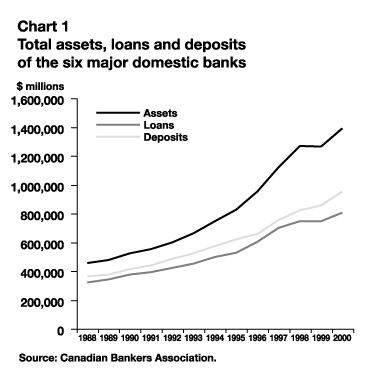

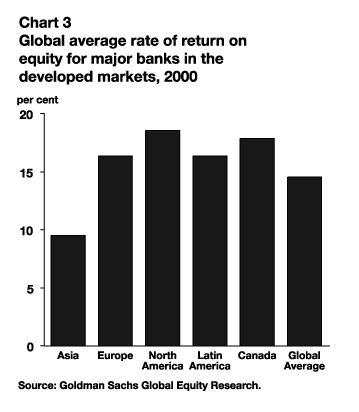
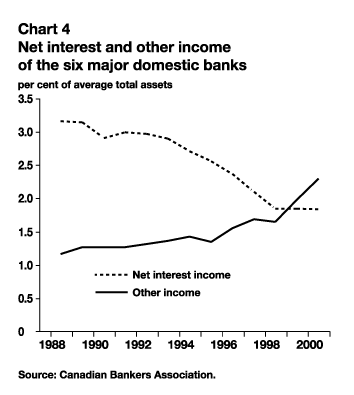
Interest income is derived mainly from lending activities to businesses and individuals, and interest earned from the banks’ own investments. Canadian interest rate spreads, which had been on a downward track over the last few years, stood at 1.53 per cent in 1999. They are now in a slightly upward trend, but remain among some of the lowest in the industrialized world (see Charts 5 and 6).
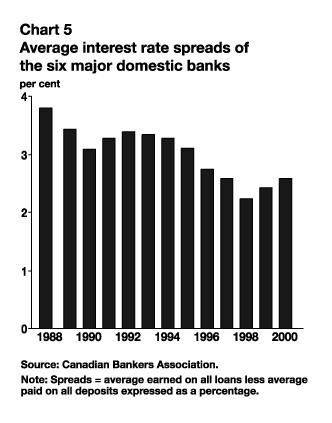

Service fee pricing practices differ significantly among countries, with most Canadian banks offering “flat-fee” banking packages that are tailored to individual needs and present considerable cost savings. According to a 1998 survey conducted for the Task Force on the Future of the Canadian Financial Services Sector, monthly service fees charged by Canadian banks are on par with those of other industrialized countries, and compare favourably with those of major banks in the United States.
Regulation and Supervision
The Financial Sector Stability Assessment undertaken by the International Monetary Fund (IMF) in 2000 indicated that “the regulatory and supervisory structure in Canada is well developed, complies with the major international principles and standards, and is a source of international best practice in a number of areas.” The IMF further noted that “Canada’s emphasis on a consolidated, risk-centered approach to supervision has put the supervisory and regulatory authorities in a good position to address the challenges faced in recent years with financial institutions embarking on new and highly complex activities.”
The soundness of the Canadian banking industry has been demonstrated many times over the past several years. Canadian banks absorbed the debt difficulties of the less developed countries in the early 1980s, the decline in real estate values a decade later, and the Asian crisis in the late 1990s without experiencing any systemic problems.
Under the Bank Act, the federal government is responsible for the regulation of the banking sector in Canada. However, given the hybrid nature of the banks’ activities, some of their subsidiary activities, such as trustee services and securities dealing, are provincially regulated.
The Office of the Superintendent of Financial Institutions (OSFI) is the federal agency principally responsible for supervising all federally regulated financial institutions and pension plans. OSFI’s role is to safeguard policyholders, depositors and pension plan members from undue loss, and to advance and administer a regulatory framework that contributes to public confidence in a competitive financial system.
The regulatory capital ratios of Canadian banks, which are defined by OSFI under the framework of risk-based capital standards developed by the Bank for International Settlements, are above the minimum requirements. The risk-based capital targets that were established by OSFI in 1999 are a Tier 1 capital ratio of at least 7 per cent and a total capital ratio of at least 10 per cent. The six largest domestic banks all surpassed these requirements in 2000 (see Chart 7).
The safety and soundness of the financial system is also enhanced by an early intervention system for troubled financial institutions, which was introduced in 1996. In addition, OSFI introduced a new risk-based supervisory framework in August 1999, which will be fine-tuned over time to ensure that supervisory practices remain effective and efficient in a rapidly changing financial marketplace.
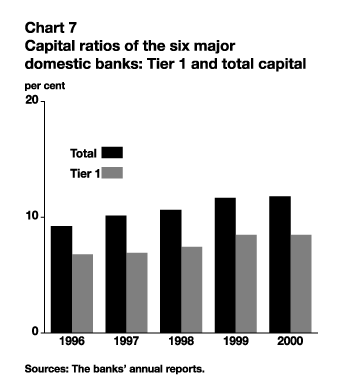
The Large Value Transfer System (LVTS), which began operations in 1999, provides settlement certainty for payments. LVTS participants are required to pledge collateral to the Bank of Canada, which ensures settlement for the participants even if one of them were to default. The Bank of Canada guarantees settlement in the extremely unlikely event that more than one LVTS participant were to fail on the same business day and the sum of the exposures of failed institutions were to exceed the collateral pledged to support such positions.
The Canada Deposit Insurance Corporation exists to protect depositors by providing deposit insurance. It also strengthens Canada’s financial system by promoting standards of sound business and financial practices.
In addition to ensuring that the regulatory environment responds to the evolution of the financial sector, the federal government takes an active interest in enhancing protection for consumers of financial services. The current Bank Act contains various provisions aimed at protecting consumer interests. These provisions, which came into force in September 1998, include requirements regarding the disclosure of borrowing costs and coercive tied-selling measures. Coercive tied selling is the practice of imposing undue pressure, or coercing a person to obtain a product or service from a bank and any of its affiliates, as a condition for obtaining a loan or any other product from that same bank.
A Framework for the Future
The legislation governing Canada’s federally regulated financial institutions is subject to review every five years. The last scheduled review was completed in 1997, and amendments to the relevant financial statutes became law in April of that year. While the revisions made at that time were designed primarily to enhance the efficiency and competitiveness of the financial sector, the federal government believed that the rapid evolution of new technologies, as well as globalization, made it necessary to provide the sector with a framework reflecting these changes.
Consequently, the Task Force on the Future of the Canadian Financial Services Sector was established in December 1996 and its report, entitled Change, Challenge, Opportunity: Report of the Task Force, was presented to the Government in September 1998. The report was subsequently reviewed by two parliamentary committees, which in turn conducted extensive public consultations and presented the Government with their own recommendations. This comprehensive consultation process led to the emergence of a broad consensus on measures to improve the sector, which was reflected in Reforming Canada’s Financial Services Sector: A Framework for the Future, a policy paper released by the Government in June 1999.
Subsequently, on February 7, 2001, the Government introduced legislation (Bill C-8) to implement the new policy framework for the financial services sector. This bill, which received Royal Assent on June 14, 2001, recognizes the changes that are taking place within the financial sector, as well as the essential need to ensure that Canada’s financial institutions have the flexibility to respond to those changes and continue to grow at home and abroad. Regulations required to implement certain provisions of the legislation are currently being drafted and will be published in the Canada Gazette. It is expected that this process will be completed in the fall of 2001, at which time the legislation will come into force.
The New Framework
The new framework includes revised ownership rules for banks and a new size-based ownership regime. Under the previous framework, a distinction was drawn between Schedule I and Schedule II banks (see Annex 1 for a list of these banks). Shares of Schedule I banks were required to be widely held, with no single shareholder or group of shareholders holding more than 10 per cent of any class of shares, while Schedule II banks could be owned by eligible Canadian or foreign financial institutions.
Under the new legislation an individual investor will now be permitted to own up to 20 per cent of any class of voting shares of a widely held bank and up to 30 per cent of any class of non-voting shares, subject only to a “fit and proper” test designed to evaluate the applicant’s character and suitability. This will allow widely held banks to enter into strategic alliances and joint ventures involving significant share exchanges. At the same time, the Bank Act will continue to prohibit control of a large financial institution by any single shareholder or group of shareholders. The Government has signalled its intention to issue guidelines that will clarify for investors and institutions the factual criteria and policy objectives to be taken into consideration in assessing control. The Government will be developing these guidelines in consultation with representatives of financial institutions and the broader investment community.
The new framework also enables banks to organize under a regulated holding-company structure that provides them with greater flexibility to compete with large specialized or unregulated firms. Both holding companies and banks structured along the traditional parent-subsidiary model are permitted to have a broader range of investments than under the previous regime.
Furthermore, the previous regime of Schedule I and Schedule II banks is now replaced by a new size-based ownership regime under which:
- large banks (banks with equity in excess of $5 billion) must remain “widely held” as outlined in the new definition;
- medium-sized banks (i.e., banks with equity between $1 billion and $5 billion) are allowed to have individual shareholdings of up to 65 per cent, with at least 35 per cent of voting shares being publicly held; and
-
small banks (i.e., banks with equity of less than $1 billion) have no ownership restrictions other than “fit and proper” tests.
The new size-based ownership regime also allows for the creation of community-based banks with services tailored to the needs of a specific clientele. These banks will still be able to compete with the major banks in local or regional markets. The new regime also allows commercial enterprises (for example, those with a significant retail presence) to own a bank.
To encourage competition, the legislation also reduces the minimum capital requirement to start a bank from $10 million to $5 million.
In support of these various initiatives, the policy framework also contains provisions to ensure that financial institutions continue to manage their risks prudently. To this end, the Superintendent of Financial Institutions has been given additional supervisory powers to deal with institutions that do not meet certain supervisory or regulatory requirements. These include the power to remove directors and senior officers of a bank in instances of misconduct, and the power to administer financial penalties against institutions and individuals that do not comply with undertakings or violate the legislation and regulations governing financial institutions.
The framework also includes merger review guidelines that outline a formal and transparent review process for merger proposals between banks with equity in excess of $5 billion. This new process consists of a review of the merger proposal by the Competition Bureau, the Office of the Superintendent of Financial Institutions and the Department of Finance, and of a full public review by the House of Commons Standing Committee on Finance and the Standing Senate Committee on Banking, Trade and Commerce.
Bill C-8 also contains consumer protection measures as well as measures to ensure that the regulatory environment responds to the evolution of the sector in today’s rapidly changing marketplace. The Financial Consumer Agency of Canada will be established to enforce the consumer-oriented provisions of the federal financial institution statutes, to monitor the industry’s self-regulatory initiatives designed to protect the interests of consumers and small businesses, to promote consumer awareness and to respond to general consumer inquiries. This will consolidate and strengthen existing oversight activities in a dedicated new agency.
A new Canadian Financial Services Ombudsman will also be established to handle consumer and smallbusiness complaints related to dealings with financial institutions. This independent body will operate at arm’s-length from government and the financial sector, and a majority of the members of its board of directors will be from outside the financial services sector.
Additional consumer protection measures include better access to basic financial services, the provision of low-cost accounts, notice provisions for branch closures, and a broadening of the existing Bank Act provision on coercive tied selling. Moreover, federal financial institutions with equity in excess of $1 billion will be required to provide annual public accountability statements that describe their contributions to the Canadian economy and society.
Looking Ahead
Today’s financial world is rapidly changing. Technology and global competition are significantly altering the structure of the Canadian banking industry. Canadian banks are facing increased competition from other established financial service providers and new foreign entrants. New technology and the Internet are also enabling competitors to enter the market without having to invest in branches, which presents further challenges to Canada’s banking sector.
To address these challenges, the major domestic banks have made significant investments in technology in order to provide products and services that are innovative, meet consumer demands and enhance their competitiveness. They have integrated and restructured their business activities in order to be more cost-efficient and entered into alliances with high-technology firms to control information technology and data-processing costs. They have also expanded their customer base through online banking and e-commerce, both in-house and through technology-based ventures and acquisitions, and targeted growth areas such as wealth management and corporate and investment banking. Further expansion in selected markets outside Canada remains a key strategy for a number of the large domestic banks, whose portion of earnings from international operations continues to grow.
Further information on legislation to reform the financial services sector can be obtained from the Department of Finance at http://www.fin.gc.ca/. Additional information on the banking sector is available from the Office of the Superintendent of Financial Institutions at http://osfi-bsif.gc.ca/ and from the Canadian Bankers Association at http://www.cba.ca/.
Annex 1*
Banks registered to do business in Canada (under the previous regulatory framework)
1. Bank of Montreal
2. The Bank of Nova Scotia
3. Canadian Imperial Bank of Commerce
4. Canadian Western Bank
5. Laurentian Bank of Canada
6. National Bank of Canada
7. Royal Bank of Canada
8. TD Bank Financial Group (including Canada Trust)
Schedule II Banks
1. ABN AMRO Bank Canada
2. Amex Bank of Canada
3. Banca Commerciale Italiana of Canada
4. Bank of America Canada
5. Bank of China (Canada)
6. Bank of East Asia (Canada)
7. Bank of Tokyo-Mitsubishi (Canada)
8. Bank One Canada
9. BNP Paribas (Canada)
10. Chase Manhattan Bank of Canada (The)
11. Citibank Canada
12. Citizens Bank of Canada**
13. Comerica Bank – Canada
14. Credit Suisse First Boston Canada
15. CS Alterna Bank**
16. CTC Bank of Canada
17. Deutsche Bank Canada
18. Dresdner Bank Canada
19. First Nations Bank of Canada**
20. Habib Canadian Bank
21. Hanvit Bank Canada
22. HSBC Bank Canada
23. ING Bank of Canada
24. International Commercial Bank of Cathay (Canada)
25. J.P. Morgan Canada
26. Korea Exchange Bank of Canada
27. Manulife Bank of Canada**
28. MBNA Canada Bank
29. Mizuho Bank
30. National Bank of Greece (Canada)
31. President’s Choice Bank**
32. Rabobank Canada
33. Société Générale (Canada)
34. Sottomayor Bank Canada
35. State Bank of India (Canada)
36. Sumitomo Mitsui Banking Corporation of Canada
37. UBS Bank (Canada)
38. UFJBank Canada
39. United Overseas Bank (Canada)
Foreign Bank Branches – Full-Service
1. Bank One, NA
2. Bayerische Landesbank Girozentrale
3. Capital One Bank (Canada Branch)
4. Chase Manhattan Bank (The)
5. Deutsche Bank AG
6. Maple Bank
7. Mellon Bank, N.A.
8. Morgan Guaranty Trust Company of New York
9. Rabobank Nederland
10. State Street
11. U.S. Bank National Association
Foreign Bank Branches – Lending
1. National City
* As of August 2001.
** Domestic Schedule II banks.
Note: The 13 domestic banks include the Schedule I banks and the Schedule II banks marked with a **.
Annex 2
The six largest banks by assets (October 31, 2000)
|
|
|
|---|---|
|
Bank |
Assets |
|
|
|
|
|
($ billions) |
|
Royal Bank of Canada |
291 |
|
Canadian Imperial Bank of Commerce |
268 |
|
TD Bank Financial Group (including Canada Trust) |
265 |
|
The Bank of Nova Scotia |
253 |
|
Bank of Montreal |
233 |
|
National Bank of Canada |
76 |
| Last Updated: 2004-11-03 | |||||